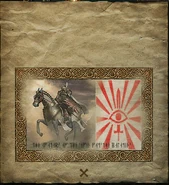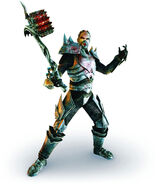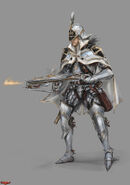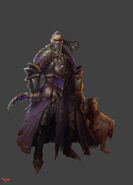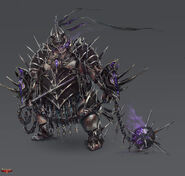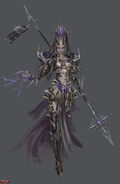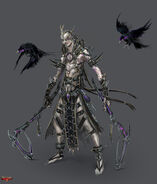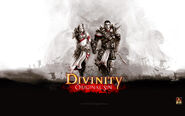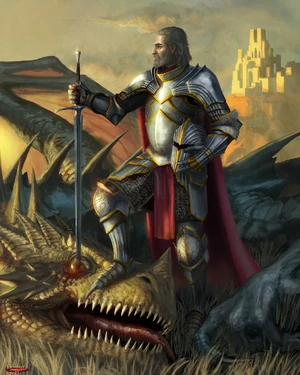
Painting depicting human hero from Divine Ascension
“Humans are Rivellon’s most populous race and, since the advent of the Divine Order, its most powerful, too. Versatile, resourceful, and opportunistic, humanity has spread across Rivellon, filling every niche we find. Although we are the largest race in the world, the Magisters’ recent attitude toward the containment of Source has also left us the most bitterly divided.
„
Humans are one of the seven races that inhabit Rivellon.
Physiology[]
In comparison to other races, humans are more or less average species. They are not the tallest, strongest, nor do they have the most generous life span. Unlike other races, however, humans are blessed with ingenuity, adaptability and cunning which they use in order to survive. These qualities have catapulted them into a position of "undisputed pre-eminence" in many of Rivellon´s notable regions.[1]
Culture[]
Families[]
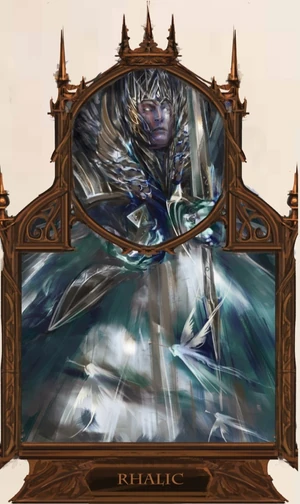
The god Rhalic
“The human family is much like a hardy wildflower – it can take root and prosper in the unlikeliest of places. But turn your back for nary a moment and you may find it has taken over.
„—Modern Chronicles of Reapers´s Coast by Cranley Huwbert
Humans tend to live in tight-knit clans with a strong inclination towards community values. Many humans live in the same area for their whole life but it is not uncommon for some to venture away from home in search of work when the need arises. For example, a mother or father will leave the home for a number of months to perform seasonal work in order to support their family. In other cases it is the overpopulation that forces younger generations to seek a new home. Due to human's flexible nature and preference of adaptation over tradition they were able to expand their culture in various regions without facing any sort of major resistance.[2]
Government[]
Despite being the youngest of the seven races, human governments have varied widely across history. From the vast empires during the Dragon War to the monarchies of the Era of Source, to the modern-day rule of the Divine Order. Unlike orcs or lizards, humans have developed a propensity towards cultural dominance rather than physical colonialism. Thanks to humans' flexible culture many of their customs such as their standard of dress, religion, and entertainment were quick to take root.
Human will is so strong that it was possible for a leader to rise amongst them and meet with support of other races across Rivellon. Lucian the Divine is a perfect example of how much influence can human leaders achieve on Rivellon.[1]
Assassins Guild of Verdistis[]
"While I don't think you'll find any noblemen who'll admit it, politics have become impossible without at least knowing how to contact the guild of assassins in Verdistis. Their skill is unquestionable, their discretion guaranteed, and their record impeccable. If an assassin of the black guild accepts a commission, the target can start writing his last will, for there's no way he'll escape his ill fate. Their efficiency alone serves as a good reason for their popularity among the less scrupulous nobles, but there's more. The leadership of the guild consists entirely of businessmen, and for the right price, one can buy immunity from them. The immunity guarantees that for a certain period of time, the guild will not accept any commissions with the bearer of the immunity as a target, no matter what the price. It goes without saying that this policy has significantly spiced the guild's treasury. Because of this, you won't find many men in a position of power who haven't obtained immunity from the guild.
The black guild is also "lethally" opposed to non-members who operate on their turf. Assassins who operate without permission of the guild are often found dead, usually only a few days after they committed a murder. Though it would be possible to exterminate the guild, or at least severely weaken it, the will to do so among the noblemen is non-existent. While costly, the immunity combined with the guild's way of dealing with competition, effectively guarantees that the amount of politically inspired assassinations has never been so low. On another note, it also prevents those without access to large amounts of wealth to ever reach a position of significant power, something that apparently suits most of the nobles just fine.
Rumor has it that the founder of the black guild was a high-ranking servant in the pre-stormfist days during Nericon's rule (See the story of Nericon and Zandalor for more details). It was the old tyrant himself who taught this servant the art of silently eliminating unwanted elements. When Nericon died and the Stormfist family seized power, the servant fled the castle taking with him an intimate knowledge of how to access the castle through secret corridors. It didn't take long before he was approached by noblemen and merchants. They thought that the newly installed rulers were irrationally opposed to what that they called "a decent way of making a living", and suggested that there was a fortune to be made if the servant would assist them by taking up his old job.
Instead of accepting their offer, the servant slipped into the castle straight into the chambers of the new ruler. What happened in those chambers will probably remain a mystery forever, but it is an established fact the same nobles and merchants who had approached the servant, were found dead soon after." - The Assassin - Divine Divinity description[3]
Era of the Divine Order[]
Since Lucian ascended to divinity in 1218 AD, humans were under the rule of his Divine Order of Lucian. Shortly after its creation the Order was mainly made to battle the Black Ring, Voidwoken and all manner of evil influence across Rivellon while maintaining alliances with other the races. While the Lucian's order ruled human lands the nobles who were originally in charge of their lands joined his order and continued to oversee their lands. All of these nobles joined the Divine Order as Divine Paladins.
Religion[]
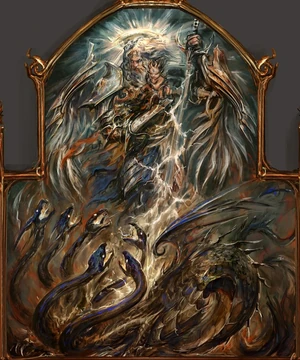
Religious painting of Lucian the Divine depicting his victory over the Demon of Lies
Ever since their creation, humans worshipped their creator the god Rhalic whilst also revering the other Seven Gods. Along with the Seven Gods, humans tend to turn to Astarte, Ouroboros and his children. Humans who practiced dark arts, often turned to Lord of Chaos or rarely to the God King for power, prior to the Sealing of the Veil.
Since the advent of Divine Order, most humans started to worship Lucian as their god, alongside Rhalic. After the Source Drought in 1242 AD humans mainly worshipped Lucian, this worship became more widespread, with Lucians supposed ascension to godhood during the Great War between 1244 AD and 1250 AD, when he was presumed slain by a rogue Dragon Knight and his remains were never found.
Appearance in games[]
Divinity: Dragon Commander[]
In this game the player assumes the role of a son of human Emperor Sigurd and Ancient dragon Aurora.
Divinity: Original Sin[]
In Divinity Original Sin the player takes control of two human heroes.
Divine Divinity[]
In Divine Divinity player can choose one of six human characters. Canon hero of this game is Lucian (male warrior preset)
Beyond Divinity[]
In Beyond Divinity the player controls human paladin member of Divine Order and a Death Knight.
Divinity: Original Sin 2[]
“Adventurous, confident, flexible, at times even clever, humans are dominant in Rivellon. They always play the hero in their own endless wars ... even when they´re the villains.
„—Race description in Divinity: Original Sin II Definitive Edition
- Alexandar
- Ifan ben-Mezd - chosen godwoken champion of Rhalic
- Lohse
Divinity II: Dragon Knight Saga[]
- In Divinity II Dragon Knight Saga player takes control of a dragon slayer initiate.
Notes[]
- Humans are the only race which is playable in all games.
- Like other races. In Early Access of DOS2 their description has been in changed in official release. The original description was:
“Adaptable, expansionist and superstitious, humans are the dominant race of Rivellon. Civil wars have ravaged their lands, but not their authority.
„—race description in Divinity Original Sin 2 early access
Gallery[]
Concept Art[]
Wallpaper[]
References[]
- ↑ 1.0 1.1 Modern Chronicles of Reaper's Coast, Cranley Huwbert, page 19
- ↑ Modern Chronicles of Reapers´s Coast by Cranley Huwbert, page 21
- ↑ The Assassin - Divine Divinity website description accessed via Wayback Machine

